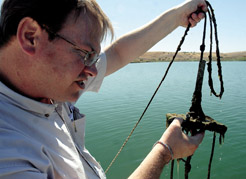
San Luis Reservoir to remain closed for time being
San Luis Reservoir to remain closed for time being
The multi-year process of ridding San Justo Reservoir of invasive zebra mussels is moving forward this month with the impending release of an environmental document for public review.
The San Benito County Water District, working in conjunction with the federal Bureau of Reclamation, is seeking public comment on a plan to treat the infested reservoir with potash to kill the fingernail-sized mussels first discovered at the Union Road waterway in January 2008.
The popular boating and fishing area has been closed to the public ever since to prevent the spread of the freshwater creatures, which are harmful to water systems because they produce toxins that kill native organisms. They also reproduce so quickly and in such great numbers that they can clog drinking water or agricultural irrigation delivery systems.
Water district chief Jeff Cattaneo expects the environmental review documents to be available by the end of next week, both online and in the water district offices. After a 30-day period, the district plans to review and address the comments in March and then certify the plan with the district board.
At the same time, the Bureau of Reclamation will be conducting an environmental review of its own. When those two documents are completed, a final eradication plan will be designed and the agencies will approach Congress to seek an appropriation to fund the work. Final numbers aren’t available, but it is estimated that the project will cost $2 million to $3 million, according to Cattaneo.
The plan involves drawing down the reservoir level and trying to kill the mussels with potash, or potassium chloride, a type of salt that disrupts mussels’ ability to filter feed. Officials believe the potash would force the mussels to open up, at which time they could be killed with chlorine or left to die on their own.
Any eradication plan would not begin for a year or more, according to Cattaneo, as many bureaucratic hurdles must first be jumped.
Asked how optimistic he is about funding prospects for the project, Cattaneo said, “it all depends on what the money situation is going to be over the next few years. Also, how important people see this project being it’s one that’s going to help the rest of the agencies that have issues with zebra and quagga mussels to further the science to effect and eradication.”
Environmental concerns on the project, Cattaneo said, “are fairly benign.”We’ve been working with the fish and wildlife service and the Department of Fish and Game, so I don’t expect we’re going to get a lot of concerns.”
In the meantime, the reservoir will remain closed to the public “until we come up with a plan that addresses how much public access there is going to be and how we can monitor that access in the future,” Cattaneo said. “It’s still something we’re working toward. The plan is definitely to open it up at some point. We first need to find out if the (mussel eradication plan) is successful. If it is, we want to make sure the reservoir doesn’t become re-infected. If it’s not successful, we want to make sure we don’t allow other waters to become infected with zebra mussels.”
For a copy of the zebra mussel eradication environmental documents, visit the office at 30 Mansfield Road, call 637-8218, or go online to www.sbcwd.com.









